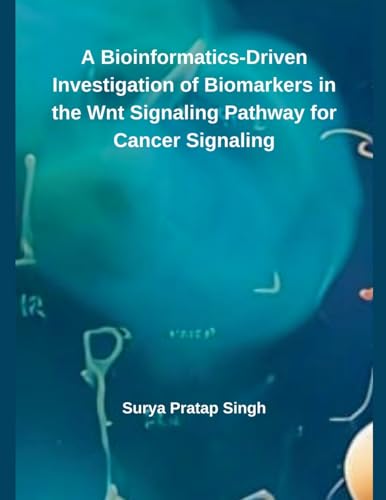A Bioinformatics-Driven Investigation of Biomarkers in the Wnt Signaling Pathway for Cancer Signaling - Couverture souple

Synopsis
Cell signaling is a way of communication among the living cells and involves the processing of biochemical information to regulate metabolic and cellular activities of the organism. The process of signaling initiates with a chemical species (i.e. ligands or signaling molecules) and ends with the cellular responses. The signal molecules are recognized by the receptors on the surface of target cells and the message is transferred inside the cell in series of steps, the signal transduction pathway, to produce the desired effects. Many signaling pathways have been studied for their involvement in cellular processes such as differentiation and proliferation. One such pathway is Wnt-signaling pathway which is an ancient and highly conserved among all metazoans; it is known to have roles in regulating life processes such as embryonic development, cell growth and survival, cell differentiation, migration and polarity (Wodarz et al., 1998). The term Wnt is derived from the name of two genes viz. wingless gene of Drosophila which is a segment polarity gene and its vertebrate homolog integrated or int-1 (Komiya and Habas, 2008). The extracellular signaling molecule of this pathway (i.e. ligand) is a glycoprotein known as Wnt, which binds to, and dimerize, two receptors namely LRP6/5 and Fz. The downstream signal is transported to the nucleus and promotes the transcription of Wnt responsive genes which ultimately regulate a wide variety of cellular processes including cell fate determination, motility, polarity, primary axis formation, stem cell renewal and organogenesis. The intracellular
Les informations fournies dans la section « Synopsis » peuvent faire référence à une autre édition de ce titre.
Résultats de recherche pour A Bioinformatics-Driven Investigation of Biomarkers...
A Bioinformatics-Driven Investigation of Biomarkers in the Wnt Signaling Pathway for Cancer Signaling
Vendeur : GreatBookPrices, Columbia, MD, Etats-Unis
Etat : New. N° de réf. du vendeur 48919444-n
Acheter neuf
Expédition nationale : Etats-Unis
Quantité disponible : Plus de 20 disponibles
A Bioinformatics-Driven Investigation of Biomarkers in the Wnt Signaling Pathway for Cancer Signaling
Vendeur : California Books, Miami, FL, Etats-Unis
Etat : New. N° de réf. du vendeur I-9798227849342
Acheter neuf
Expédition nationale : Etats-Unis
Quantité disponible : Plus de 20 disponibles
A Bioinformatics-Driven Investigation of Biomarkers in the Wnt Signaling Pathway for Cancer Signaling
Vendeur : GreatBookPrices, Columbia, MD, Etats-Unis
Etat : As New. Unread book in perfect condition. N° de réf. du vendeur 48919444
Acheter D'occasion
Expédition nationale : Etats-Unis
Quantité disponible : Plus de 20 disponibles
A Bioinformatics-Driven Investigation of Biomarkers in the Wnt Signaling Pathway for Cancer Signaling
Vendeur : Rarewaves USA, OSWEGO, IL, Etats-Unis
Paperback. Etat : New. N° de réf. du vendeur LU-9798227849342
Acheter neuf
Expédition nationale : Etats-Unis
Quantité disponible : Plus de 20 disponibles
A Bioinformatics-Driven Investigation of Biomarkers in the Wnt Signaling Pathway for Cancer Signaling
Vendeur : Rarewaves.com USA, London, LONDO, Royaume-Uni
Paperback. Etat : New. N° de réf. du vendeur LU-9798227849342
Acheter neuf
Expédition depuis Royaume-Uni vers Etats-Unis
Quantité disponible : Plus de 20 disponibles
A Bioinformatics-Driven Investigation of Biomarkers in the Wnt Signaling Pathway for Cancer Signaling
Vendeur : Ria Christie Collections, Uxbridge, Royaume-Uni
Etat : New. In. N° de réf. du vendeur ria9798227849342_new
Acheter neuf
Expédition depuis Royaume-Uni vers Etats-Unis
Quantité disponible : Plus de 20 disponibles
A Bioinformatics-Driven Investigation of Biomarkers in the Wnt Signaling Pathway for Cancer Signaling
Vendeur : GreatBookPricesUK, Woodford Green, Royaume-Uni
Etat : New. N° de réf. du vendeur 48919444-n
Acheter neuf
Expédition depuis Royaume-Uni vers Etats-Unis
Quantité disponible : Plus de 20 disponibles
A Bioinformatics-Driven Investigation of Biomarkers in the Wnt Signaling Pathway for Cancer Signaling
Vendeur : GreatBookPricesUK, Woodford Green, Royaume-Uni
Etat : As New. Unread book in perfect condition. N° de réf. du vendeur 48919444
Acheter D'occasion
Expédition depuis Royaume-Uni vers Etats-Unis
Quantité disponible : Plus de 20 disponibles
A Bioinformatics-Driven Investigation of Biomarkers in the Wnt Signaling Pathway for Cancer Signaling
Vendeur : Rarewaves USA United, OSWEGO, IL, Etats-Unis
Paperback. Etat : New. N° de réf. du vendeur LU-9798227849342
Acheter neuf
Expédition nationale : Etats-Unis
Quantité disponible : Plus de 20 disponibles
A Bioinformatics-Driven Investigation of Biomarkers in the Wnt Signaling Pathway for Cancer Signaling
impression à la demandeVendeur : AHA-BUCH GmbH, Einbeck, Allemagne
Taschenbuch. Etat : Neu. nach der Bestellung gedruckt Neuware - Printed after ordering - Cell signaling is a way of communication among the living cells and involves the processing of biochemical information to regulate metabolic and cellular activities of the organism. The process of signaling initiates with a chemical species (i.e. ligands or signaling molecules) and ends with the cellular responses. The signal molecules are recognized by the receptors on the surface of target cells and the message is transferred inside the cell in series of steps, the signal transduction pathway, to produce the desired effects. Many signaling pathways have been studied for their involvement in cellular processes such as differentiation and proliferation. One such pathway is Wnt-signaling pathway which is an ancient and highly conserved among all metazoans; it is known to have roles in regulating life processes such as embryonic development, cell growth and survival, cell differentiation, migration and polarity (Wodarz et al., 1998). The term Wnt is derived from the name of two genes viz. wingless gene of Drosophila which is a segment polarity gene and its vertebrate homolog integrated or int-1 (Komiya and Habas, 2008). The extracellular signaling molecule of this pathway (i.e. ligand) is a glycoprotein known as Wnt, which binds to, and dimerize, two receptors namely LRP6/5 and Fz. The downstream signal is transported to the nucleus and promotes the transcription of Wnt responsive genes which ultimately regulate a wide variety of cellular processes including cell fate determination, motility, polarity, primary axis formation, stem cell renewal and organogenesis. The intracellular. N° de réf. du vendeur 9798227849342
Acheter neuf
Expédition depuis Allemagne vers Etats-Unis
Quantité disponible : 2 disponible(s)
